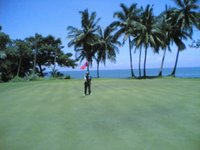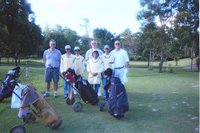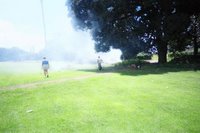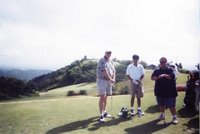

Ray had the opportunity to go to Qingdao (pronounced zing-tao) China in early July to attend a consumer electronics show. Qingdao is situated on the east coast of china and is a large seaport. It is north of Shanghai and southeast of Beijing. The population of the city itself approaches 2 million, and if you include the entire metropolitan area it is about twice that. Qingdao will host the sailing and regatta events in the 2008 Olympics, the only venue outside of Beijing. A lot of work is being done to spiff up the area, and it is looking very nice.


Being further north, the sun sets later than in Manila, so it was light here until about 7:30. After the show on the first night, Ray went down to an area known as May 4th Square to go to a restaurant. When he got there, the restaurant had closed down. Since he was there, he decided to explore the area. The May 4th Square is named for the May 4th movement of 1919 in which students protested against the government. The area is between the downtown area and the sea. Many tour buses were parked along the streets and the tour guides with their colorful pennants and megaphones were everywhere. Most of the tourists were Chinese. There are much fewer English speaking


tourists here than in Beijing or Shanghai, so it has been a little more difficult to get around.


Along the coast is a 40km walkway that goes from one end of town to another. The first section past the May 4th Square area was filled with vendors selling large conch shells, pearls, and lots of handicrafts. There must have been about 3-4 dozen stalls, and they all appeared to have the same merchandise. After the vendor’s area, the walkway opened up and followed the breakwater towards the beach area through an area called Fushan Bay. Along the breakwater, many people were down near
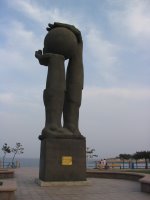
the water and picking up small crabs and even collecting the local edible seaweed. The Fushan Bay area includes the Music Square park and a covered stage along with a lot of sculptures and artwork enhancing the walk. It was a very nice walking area.

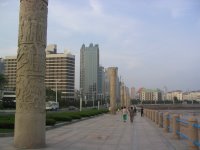
As I got to the beach area (known as No. 3 Bathing Beach), I saw some buoys ringing the swimming area, but realized that they came all the way up on shore and past the high tide point. It ends up these were shark nets that are used to keep sharks out of the swimming area. Even though there were a lot of open areas outside of the swimming area, I did not see anyone in the water in these areas, so they do heed the warnings.


I tried to set up a sightseeing tour, but they required a minimum of 6 people and did not seem to have the ability to group others together. So instead, I opted for my own tour and rented a cab to bring me to my selected sights. The rate for a cab would be about $10 an hour averaging waiting time and miles. We estimated between 5 to 6 hours to complete the tour. My driver spoke just a couple words of English, understood a couple more, but between our map and hand signals we made it just fine. The cost would not be that much different from some of the guided tours, and I would have complete flexibility. Just as a side note, there aren't too many new taxis here in Qingdao. They have all seem to run fine, but just look a little worn out. I said it seemed like they got Shanghai's hand-me-downs. I also noticed a fair amount of women cab drivers, just something that seemed different from so many places. It was not a huge amount, but enough to be noticed.


The first stop was the rotating sightseeing building on top of Mount Xinhao. There are 3 round red buildings on top of the hill, and the tallest one has a rotating floor for a 360-degree view of the city. Unfortunately today was somewhat hazy, so long distance viewing was not in the cards. There was a nice garden and pathway leading up to the top of the hill with a couple of fountains and

a lover’s bridge in the park that couples interlock a pair of padlocks on to signify their love. Many of the padlocks were heart shaped.
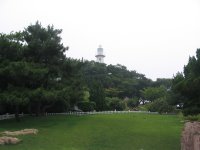

The next stop was Little Qingdao Island, home to an old lighthouse. This used to be an island, but a breakwater was built many years ago to connect the island to the land. It helps to protect the Zhangiao Pier from the direct waves of the ocean. Zhangiao Pier has a pagoda built on the end of the temple. This is the pagoda adorns the label of Tsingtao beer. Inside the breakwater is the Navy Museum with old

ships you can board and climb on. There is even a submarine there, although it is above water. Speedboat rides and jet ski rides were very popular in this area both inside and outside the breakwater.

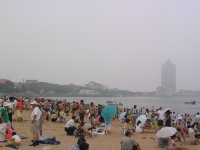
After a short ride, stopped at No. 1 Bathing Beach (there are 6 in all), and it was packed. About half the people were in street clothes, and they would roll up their pants legs and wade into the ocean. There was lots of equipment for rent such as paddle bikes, kayaks, small sailboats. There was jet skis and parasailing available. I did not see anyone doing the parasailing while I was there but did see some jet skis in action. The cost was about 480 RMB, or $60 for the parasailing. That is cheap compared to US prices, but more costly than Philippines or Thailand.
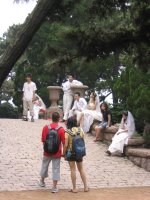

As we headed further down the coastline, we stopped at Badaguan gardens, also known as the 8 passes. It is an area of many villas built of various architecture over the last 100 years set within a wooded area. The streets (or passes) are shut off to motor vehicles on the summer weekends, so there were a lot of people strolling around the streets. Due to the beautiful

architecture and the seascape, it is a very popular place for wedding photos. There were brides, grooms, wedding parties and of course photographers all around.

With it getting close to lunchtime, I headed for the Tsingtao Brewery. They don’t tour during the lunch hour, so I headed across the street for a bite. There weren’t a lot of choices that had either an English menu or a picture menu. I finally did find a place and had some shrimp, vegetables and rice. In the US, the wait staff serves you and checks in on you; in the Philipinnes, they serve you and watch you; in China it seems as if they serve you and disappear. The food was very good and served hot, which I like. With lunch out of the way, it was on to the brewery. Tsingtao was started by the Germans here in 1903 and then fell under Japanese control during World War I. It has been successful in not only dominating the China market, but also branching out into the rest of the world. It has a very modern and clean facility. There were 2 beer stops along the way, so it was a well-done tour :)


The last stop of the day was the TV tower observation deck. I kept waiting for the haze to break all day, but it just didn’t happen. As a matter of fact, when I got to the tower, I couldn’t even see more than a quarter of the way to the top. The view from the top was non-existent. The inside is being made into a hall for Olympic memorabilia and information. Ironically, as I walked out the door, I looked up and could see the top of the tower. I quickly snapped and photo, and almost immediately the fog started to roll back across the tower.

 Ray played in a tournament at Club Intramuros in downtown Manila. The tournament was the 3rd MIT Dean's cup. MIT is not the Massachusett Institute of Technology, nor is it the University of Minnesota Institute of Technology (my alma mater), but rather one of the top local engineering schools--Mapua Institute of Technology. The course rings around the ancient walled city of Intramuros just off Manila Bay. Intramuros was originally built during the Spanish colonization period in the late 1500's and served as the capital. Inside the walls are San Agustin Church, the Manila Cathedral, and Fort Santiago. In addition are many businesses and restaurants. The course sits on what used to be a protective moat around the walls that have been filled in. It was nearly destroyed by bombing in World War II by both the Japanese who took it over and the US who eventually liberated it. Some of it has been rebuilt, and some parts have been left bombed out.
Ray played in a tournament at Club Intramuros in downtown Manila. The tournament was the 3rd MIT Dean's cup. MIT is not the Massachusett Institute of Technology, nor is it the University of Minnesota Institute of Technology (my alma mater), but rather one of the top local engineering schools--Mapua Institute of Technology. The course rings around the ancient walled city of Intramuros just off Manila Bay. Intramuros was originally built during the Spanish colonization period in the late 1500's and served as the capital. Inside the walls are San Agustin Church, the Manila Cathedral, and Fort Santiago. In addition are many businesses and restaurants. The course sits on what used to be a protective moat around the walls that have been filled in. It was nearly destroyed by bombing in World War II by both the Japanese who took it over and the US who eventually liberated it. Some of it has been rebuilt, and some parts have been left bombed out.

 The walls of Intramuros and Fort Santiago come into play at times. Our group sent a few balls into and off the walls. In more cases than not, we got favorable returns. One person in our group hit off the top of the wall (which is slightly sloped toward the course and is about 25 feet wide) and ended up on the green. On the same hole, another bounced off the top and back to the center of the fairway.
The walls of Intramuros and Fort Santiago come into play at times. Our group sent a few balls into and off the walls. In more cases than not, we got favorable returns. One person in our group hit off the top of the wall (which is slightly sloped toward the course and is about 25 feet wide) and ended up on the green. On the same hole, another bounced off the top and back to the center of the fairway.
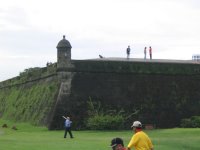 The course is very tight and relatively short. It is only a par 66 with only one par 5. Most of the par 4's are between 300 and 350 yards long, is accuracy is more important than distance. Tee boxes and greens are very close to one another, except one hole that you walk about 120 up an adjacent fairway to get to the next tee box. In another place, the fairways actually intersect, but the intersection is very close to the tee box and protected by fencing, so after the drives you are out of each others way.
The course is very tight and relatively short. It is only a par 66 with only one par 5. Most of the par 4's are between 300 and 350 yards long, is accuracy is more important than distance. Tee boxes and greens are very close to one another, except one hole that you walk about 120 up an adjacent fairway to get to the next tee box. In another place, the fairways actually intersect, but the intersection is very close to the tee box and protected by fencing, so after the drives you are out of each others way.
 The course is literally an out and back layout. If you think of the course as a horseshoe, the first and 18th are at one end, and the 9th and 10th are near the other end. There is a break house after the 9th hole. The 10th hole is the signature hole here as it has an island green forcing you to be both accurate in length and direction.
The course is literally an out and back layout. If you think of the course as a horseshoe, the first and 18th are at one end, and the 9th and 10th are near the other end. There is a break house after the 9th hole. The 10th hole is the signature hole here as it has an island green forcing you to be both accurate in length and direction.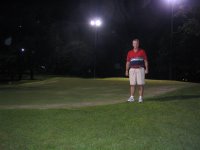 Once the sun sets, you can continue your golfing here since the entire course is lit for night play. This has made it a tourist attraction. The clubhouse has undergone a recent upgrade and is clean and well lit. There was still some work going on in the clubhouse finalizing some of the tile work. We were done before the lights came on, but I went out to have a quick picture taken. There were numerous groups still on the course. The advantage of golfing at this time is the cooler temperatures.
Once the sun sets, you can continue your golfing here since the entire course is lit for night play. This has made it a tourist attraction. The clubhouse has undergone a recent upgrade and is clean and well lit. There was still some work going on in the clubhouse finalizing some of the tile work. We were done before the lights came on, but I went out to have a quick picture taken. There were numerous groups still on the course. The advantage of golfing at this time is the cooler temperatures.

